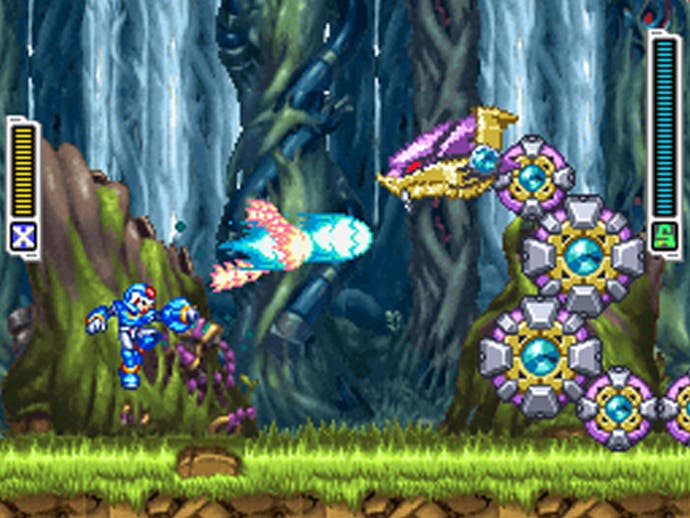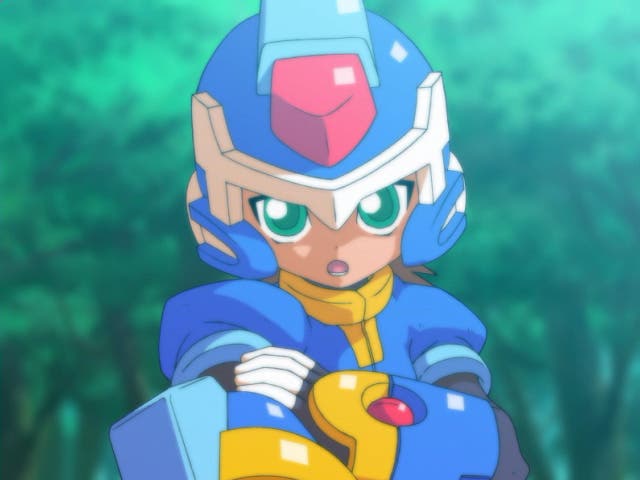Megaman ZX
Blue truth.
Megaman is a 2D action game hero defined as much by what he can't do as by what he can. The diminutive blue android's inability to duck increasingly seems like stubborn servicing of an ill-advised tradition rather than a deliberate, meaningful design decision. Likewise, when fighting a towering boss whose weak point is at a direct 45 degree angle above your position, you'll curse his ongoing failure to perform diagonal shooting today just as players did fifteen years ago.
Hard-nosed series fans assert that this is all part of the charm. By limiting Megaman's repertoire of moves to jump, shoot and skid, they argue, the experience retains a purity and simplicity. Angled shooting is for boys who can't time their jumps properly while crouching is just for cowering cowards.
As if to rub cynics' noses in the decision, Megaman ZX's lead character comes in two different forms. In the weak human form your character can duck, allowing you to squeeze through tight tunnels and easily dodge incoming bullets flying at head height. However, with no other offensive moves, this form is pointless for anything other than blending in with the game's civilians. Conversely, your second, super-souped up form, Model X, while offering the full gamut of offensive options, provides no crouch. As such you have to switch between each form to negotiate even the simplest of low ceilings before taking out an enemy. It's an unsatisfactory compromise that's more irritating than liberating.
Despite this admittedly overarching grievance with the Megaman template, this latest DS iteration, which follows on from the GBA's competent side-scrolling action titles, is good and interesting. Its designers have chosen to borrow some of the 2D Metroid and Castlevania games' ideas, shoehorning Megaman's bright futuristic pixels into a sprawling 2D world of interconnected areas to explore.

You play either as a young boy, Vent or a girl , Aile, each of whom share similar abilities but whose stories differ slightly. The pair work as couriers for the delivery company, Giro Express. They are delivering an unknown package when they come under attack from some rogue robots, named Mavericks. In the skirmish the package spills open to reveal a shard of 'Biometal', a metallic substance that fuses with your character, turning them into a 'Model X' super-human. There are five different types of biometal to be found in the game, each of which bestows a slightly different Model X form, each one unique and necessary to successfully negotiate the game's diverse areas,
Data terminals are spread throughout the world (much like Castlevania's save rooms) and from a terminal in these rooms you accept missions. You can only take on one mission at a time and these usually take the form of basic find, fetch or destroy quests. However, as you can choose which order you want to complete missions, the game becomes mildly non-linear. Thanks to an appalling map system (which only shows how whole areas connect to one another rather than the exact layout of each environment) it's easy to get lost in the world and, as save rooms are rare and enemies throughout are tough (even on the easy setting) the game is more frustrating in this regard than it needed to be.

The open-endedness is compromised by the inevitable level design blockages, which require you to have won certain upgrades before you can access areas of the gameworld. Collecting new abilities to unlock new parts of the wholly interconnected map is compelling but somehow lacks the creativity and charm of those 2D masterpieces it apes. Whereas in Castlevania your character might gain the ability to temporarily shift into a puff of smoke in order to slip through an air vent, in Megaman ZX you'll often just gain an arbitrary upgrade to your keycard allowing, for example, access to yellow doors. It lacks a little imagination and is not helped by some very bad signposting that can have you traipsing around the game aimlessly searching for what you need next.
Megaman ZX is a pretty game with bright primary coloured visuals and well-animated sprites. The parallax backgrounds are deep and effective but do little outside of the anime FMV cut scenes that couldn't be achieved on a GBA. Likewise the lack of meaningful touchscreen functionality is initially noticeable in its absence but, in the long run, this decision is probably preferable. Control is tight and refined so forcing gimmicky touchscreen mechanics into the game would likely to have only have drawn criticism.
However, there are some design elements that will be off-putting to gamers, especially those not brought up in tougher 2D action gaming times. Blind jumps, enemies that re-spawn almost instantly combined with boss battles that often require repeated attempts make this a difficult game. But the formula has been expertly updated here and, while the game never achieves the excellence of those titles from which it draws heavy inspiration, this is still a competent and engaging proposition.

